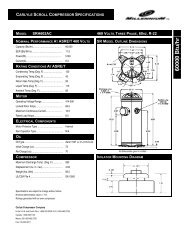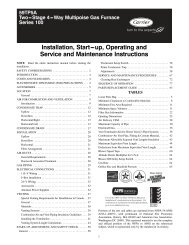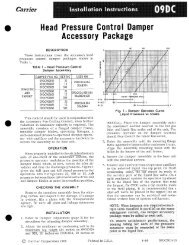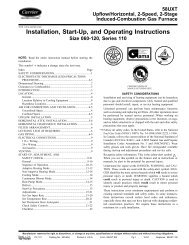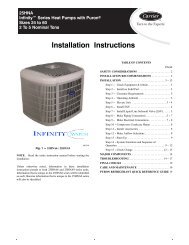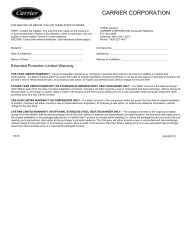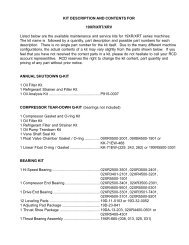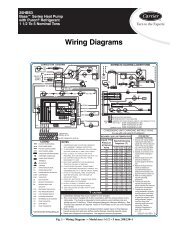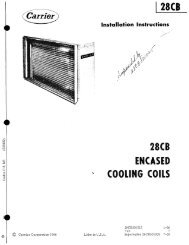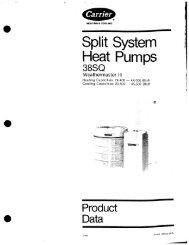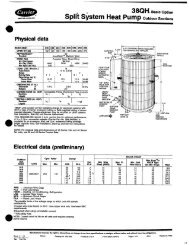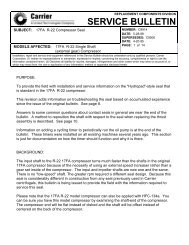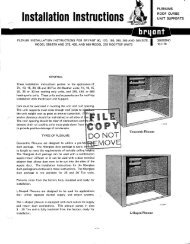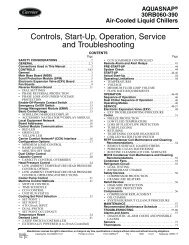Product Data - Carrier
Product Data - Carrier
Product Data - Carrier
You also want an ePaper? Increase the reach of your titles
YUMPU automatically turns print PDFs into web optimized ePapers that Google loves.
Controls<br />
Operating sequence<br />
Cooling, units without economizer — When thermostat<br />
calls for cooling, terminals G and Y1 are energized. The<br />
indoor (evaporator) fan contactor (IFC) and compressor contactor<br />
no. 1 (C1) are energized, and evaporator-fan motor<br />
(IFM), compressor no. 1 (48TJ004-014 and 020-028) or<br />
unloaded compressor (48TJ016), and condenser fan(s) start.<br />
The condenser-fan motor(s) runs continuously while unit is<br />
cooling. For units with 2 stages of cooling, if the thermostat<br />
calls for a second stage of cooling by energizing Y2,<br />
compressor contactor no. 2 (C2) is energized and compressor<br />
no. 2 starts (48TJ008-014 and 020-028), or compressor<br />
no. 1 runs fully loaded (48TJ016).<br />
Heating, units without economizer (48TJ004-014)<br />
— When the thermostat calls for heating, terminal W1 is<br />
energized. In order to prevent thermostat short-cycling, the<br />
unit is locked into the Heating mode for at least 1 minute<br />
when W1 is energized. The induced-draft motor (IDM) is<br />
then energized and the burner ignition sequence begins.<br />
The indoor (evaporator) fan motor (IFM) is energized<br />
45 seconds after a flame is ignited. On units equipped for<br />
two stages of heat, when additional heat is needed, W2 is<br />
energized and the high-fire solenoid on the main gas valve<br />
(MGV) is energized. When the thermostat is satisfied and<br />
W1 is deenergized, the IFM stops after a 45-second timeoff<br />
delay.<br />
Heating, units without economizer (48TJ016-028)<br />
NOTE: The 48TJ016-028 units have 2 stages of heat.<br />
Set thermostat system switch at HEAT or AUTO. position<br />
and set fan switch to AUTO. position for heating.<br />
When first-stage thermostat calls for heat, time-delay relay<br />
for evaporator fan begins timer sequence. Induced-draft<br />
relay closes, and induced-draft motor starts.<br />
Draft pressure switch closes and pilot valve no. 1 opens,<br />
allowing gas to flow to the first-stage pilot. Spark ignitor ignites<br />
pilot flame. Sensor detects flame and the main gas<br />
valve no. 1 opens. Gas flows to main burners and first-stage<br />
burners ignite. Spark ignitor turns off.<br />
When sequence is complete, time-delay relay closes and<br />
evaporator fans start.<br />
SECOND STAGE — 48TJD016-028 LOW-HEAT AND<br />
48TJE016 HIGH-HEAT UNITS — With an additional heating<br />
call, the second-stage thermostat closes. (The control<br />
relay closes during the first stage of operation.) Pilot valve<br />
no. 2 opens, and the spark ignitor ignites pilot. The sensor<br />
detects a flame and energizes main gas valve coil no. 2,<br />
opening main gas valve no. 2. Gas flows to the main burners,<br />
and the second stage burners ignite. The spark ignitor<br />
turns off.<br />
When the second-stage thermostat is satisfied, the secondstage<br />
gas valve closes.<br />
When the first-stage thermostat is satisfied, the first-stage<br />
gas valve closes. The induced-draft motor turns off, the time<br />
relay opens, and the timer sequence begins. When the sequence<br />
is complete, the evaporator-fan motor turns off.<br />
SECOND-STAGE — 48TJE024,028 HIGH-HEAT UNITS<br />
— With an additional heating call, the second-stage thermostat<br />
closes. (The control relay closes during the first stage<br />
of operation.) The second-stage induced-draft relay closes,<br />
and the second-stage induced-draft motor starts.<br />
The second-stage draft pressure switch closes and pilot<br />
valve no. 2 opens, allowing gas to flow to the second-stage<br />
pilot. Spark ignitor ignites pilot flame. The sensor detects<br />
the flame, and main gas valve no. 2 opens. Gas flows to<br />
main burners and second-stage burners ignite. Spark ignitor<br />
turns off.<br />
When the second-stage thermostat is satisfied, the secondstage<br />
gas valve closes and the second-stage induced-draft<br />
motor turns off.<br />
When the first-stage thermostat is satisfied, the first-stage<br />
gas valve closes. The first-stage induced-draft motor turns<br />
off, the time relay opens, and the timer sequence begins.<br />
When the sequence is complete, the evaporator-fan motor<br />
turns off.<br />
Cooling, units with Durablade economizer (48TJ004-<br />
014) — When the outdoor-air temperature is above the<br />
OAT (outdoor-air thermostat) setting and the room thermostat<br />
calls for cooling, compressor contactor no. 1 is energized<br />
to start compressor no. 1 and the outdoor (condenser)<br />
fan motor (OFM). The indoor (evaporator) fan motor (IFM)<br />
is energized and the economizer damper moves to the minimum<br />
position. Upon a further call for cooling, compressor<br />
contactor no. 2 will be energized, starting compressor<br />
no. 2 (008-014 only). After the thermostat is satisfied, the<br />
damper moves to the fully closed position when using an<br />
auto fan or to the minimum position when using a continuous<br />
fan.<br />
When the outdoor-air temperature is below the OAT setting<br />
and the thermostat calls for cooling, the economizer<br />
dampers move to the minimum position. If the supply-air<br />
temperature is above 57 F, the damper continues to open<br />
until it reaches the fully open position or until the supply-air<br />
temperature drops below 52 F.<br />
When the supply-air temperature falls to between 57 F<br />
and 52 F, the damper will remain at an intermediate open<br />
position. If the supply-air temperature falls below 52 F, the<br />
damper will modulate closed until it reaches the minimum<br />
position or until the supply-air temperature is above 52 F.<br />
When the thermostat is satisfied, the damper will move to<br />
the fully closed position when using an auto fan or to the<br />
minimum position when using a continuous fan.<br />
If the outdoor air alone cannot satisfy the cooling requirements<br />
of the conditioned space, economizer cooling is integrated<br />
with mechanical cooling, providing second-stage<br />
cooling. Compressor no. 1 and the condenser fan will be<br />
energized and the position of the economizer damper will<br />
be determined by the supply-air temperature. Compressor<br />
no. 2 is locked out.<br />
When the second stage of cooling is satisfied, the compressor<br />
and OFM will be deenergized. The damper position<br />
will be determined by the supply-air temperature.<br />
After a 30-second delay, the IFM shuts off. If the thermostat<br />
fan selector switch is in the ON position, the IFM<br />
will run continuously.<br />
Cooling, units with Parablade economizer (48TJ004-<br />
007) — When the outdoor air is above the enthalpy control<br />
(EC) setting, and the room thermostat calls for cooling,<br />
and the compressor contactor is energized to start the compressor<br />
and the condenser-fan motor. The evaporator-fan<br />
motor is energized and the economizer damper moves to<br />
59



